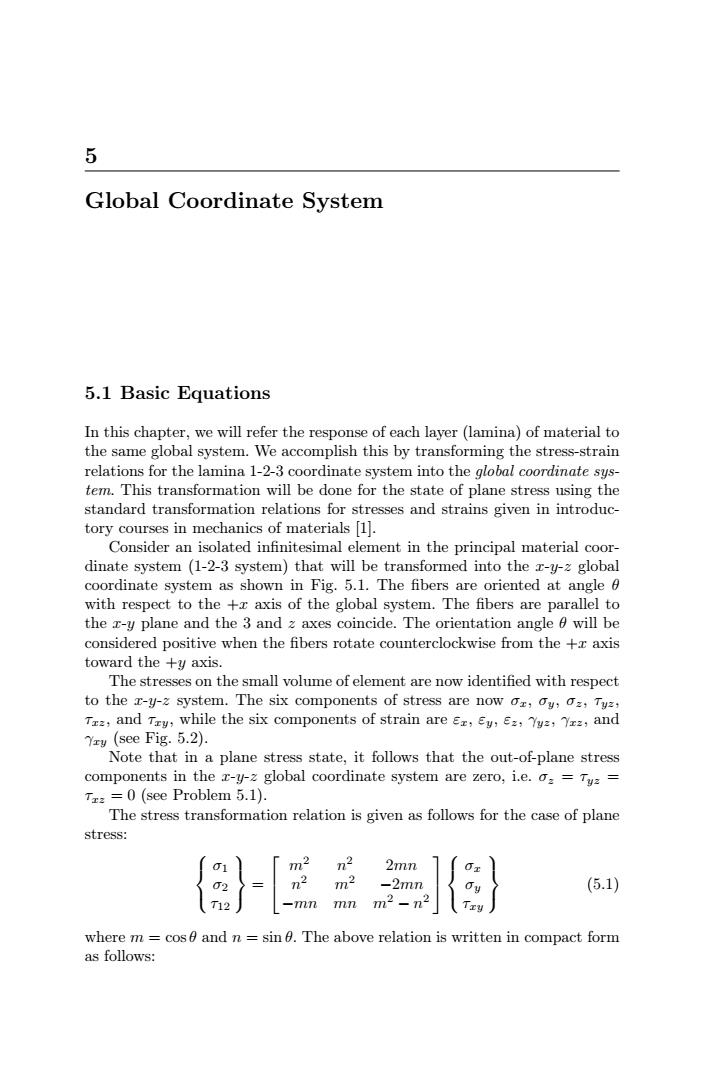正在加载图片...

5 Global Coordinate System 5.1 Basic Equations In this chapter,we will refer the response of each layer (lamina)of material to the same global system.We accomplish this by transforming the stress-strain relations for the lamina 1-2-3 coordinate system into the global coordinate sys- tem.This transformation will be done for the state of plane stress using the standard transformation relations for stresses and strains given in introduc- tory courses in mechanics of materials [1]. Consider an isolated infinitesimal element in the principal material coor- dinate system (1-2-3 system)that will be transformed into the z-y-z global coordinate system as shown in Fig.5.1.The fibers are oriented at angle with respect to the +x axis of the global system.The fibers are parallel to the z-y plane and the 3 and z axes coincide.The orientation angle 6 will be considered positive when the fibers rotate counterclockwise from the +x axis toward the +y axis. The stresses on the small volume of element are now identified with respect to the r-y-z system.The six components of stress are now oz,oy,o=,Tyz, T,and Ty,while the six components of strain are ,y,,,Y,and Yry (see Fig.5.2). Note that in a plane stress state,it follows that the out-of-plane stress components in the z-y-z global coordinate system are zero,i.e.o:=Tyz= Tz2=0(see Problem 5.1). The stress transformation relation is given as follows for the case of plane stress: 2 n2 2mn n2 23 -2m (5.1) T12 -mn mn m2-n2 where m cos and n sin 0.The above relation is written in compact form as follows:5 Global Coordinate System 5.1 Basic Equations In this chapter, we will refer the response of each layer (lamina) of material to the same global system. We accomplish this by transforming the stress-strain relations for the lamina 1-2-3 coordinate system into the global coordinate system. This transformation will be done for the state of plane stress using the standard transformation relations for stresses and strains given in introductory courses in mechanics of materials [1]. Consider an isolated infinitesimal element in the principal material coordinate system (1-2-3 system) that will be transformed into the x-y-z global coordinate system as shown in Fig. 5.1. The fibers are oriented at angle θ with respect to the +x axis of the global system. The fibers are parallel to the x-y plane and the 3 and z axes coincide. The orientation angle θ will be considered positive when the fibers rotate counterclockwise from the +x axis toward the +y axis. The stresses on the small volume of element are now identified with respect to the x-y-z system. The six components of stress are now σx, σy, σz, τyz, τxz, and τxy, while the six components of strain are εx, εy, εz, γyz, γxz, and γxy (see Fig. 5.2). Note that in a plane stress state, it follows that the out-of-plane stress components in the x-y-z global coordinate system are zero, i.e. σz = τyz = τxz = 0 (see Problem 5.1). The stress transformation relation is given as follows for the case of plane stress: ⎧ ⎨ ⎩ σ1 σ2 τ12 ⎫ ⎬ ⎭ = ⎡ ⎣ m2 n2 2mn n2 m2 −2mn −mn mn m2 − n2 ⎤ ⎦ ⎧ ⎨ ⎩ σx σy τxy ⎫ ⎬ ⎭ (5.1) where m = cos θ and n = sin θ. The above relation is written in compact form as follows: